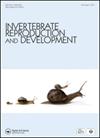佛罗里达广播海参独特的生殖生物学:育苗地内对成虫的兼性招募
IF 0.8
4区 生物学
Q4 REPRODUCTIVE BIOLOGY
引用次数: 3
摘要
摘要对于大多数商业海参来说,新定居的幼崽和招募过程的信息很少,这阻碍了对苗圃栖息地的保护,而这是管理的关键。在这里,研究了佛罗里达Holothuria早期生命阶段的生态学。在实验室实验中,雌性释放少量卵母细胞,卵母细胞经历了短暂的卵磷脂营养发育。在广播产卵期间,一些负浮力和粘性的卵母细胞定居在成虫身上,在那里它们一直锚定到五轴期(被封装)。在伯利兹的Placencia泻湖采集的几只野生成虫,每只有2个繁殖体(卵、囊胚、五轴体、幼虫)。苗圃生境以成虫密度高、靠近红树林的浅层海草床、泥质基质为主为特征。本研究阐明了Holothuroidea中一个自由产卵的卵泡营养性物种的独特的兼性后代-成虫关联,可能代表了一种介于放生和体外孵育之间的杂交状态。这种不寻常的繁殖特征可能确保在热带美洲竞争最激烈的栖息地之一成功地进行本地招募,那里的捕食压力可能非常高。本文章由计算机程序翻译,如有差异,请以英文原文为准。
Unique reproductive biology of the broadcasting sea cucumber Holothuria floridana: facultative recruitment on adults inside nursery grounds
ABSTRACT Information on newly settled juveniles and recruitment processes in sea cucumbers is sparse for most commercial species, impeding protection of nursery habitats, which are key to management. Here, the ecology of early life stages of Holothuria floridana was investigated. In laboratory experiments, females released a small number of oocytes, which underwent abbreviated lecithotrophic development. During broadcast spawning, some of the negatively buoyant and sticky oocytes settled on the adults where they remained anchored up to the pentactula stage (encapsulated). Several wild adults collected in the Placencia Lagoon (Belize) each hosted ~2 propagules (eggs, blastulae, pentactulae, juveniles). The nursery habitat was characterized by high adult density, shallow seagrass beds close to mangroves, and mud dominated substrata. The present work illustrates a unique facultative offspring-adult association in a free-spawning lecithotrophic species of Holothuroidea, possibly representing a hybrid state between broadcasting and external brooding. This uncommon reproductive feature may ensure successful local recruitment in one of the most competitive habitats of the tropical Americas, where predation pressure is likely to be very high.
求助全文
通过发布文献求助,成功后即可免费获取论文全文。
去求助
来源期刊
CiteScore
1.90
自引率
0.00%
发文量
21
审稿时长
>12 weeks
期刊介绍:
Invertebrate Reproduction & Development ( IRD) presents original research on the reproductive and developmental biology of the Invertebrata, both embryonic and postembryonic. IRD welcomes papers reporting significant results obtained using new techniques. Encouraged topic areas include: aquaculture, physiology, biochemistry, functional morphology, phylogeny, behavioural and regulatory mechanisms, including genetic, endocrine and molecular studies. Papers containing qualitative descriptions of reproductive cycles and gametogenesis will not be considered. IRD is published in association with the International Society of Invertebrate Reproduction and Development.

 求助内容:
求助内容: 应助结果提醒方式:
应助结果提醒方式:


